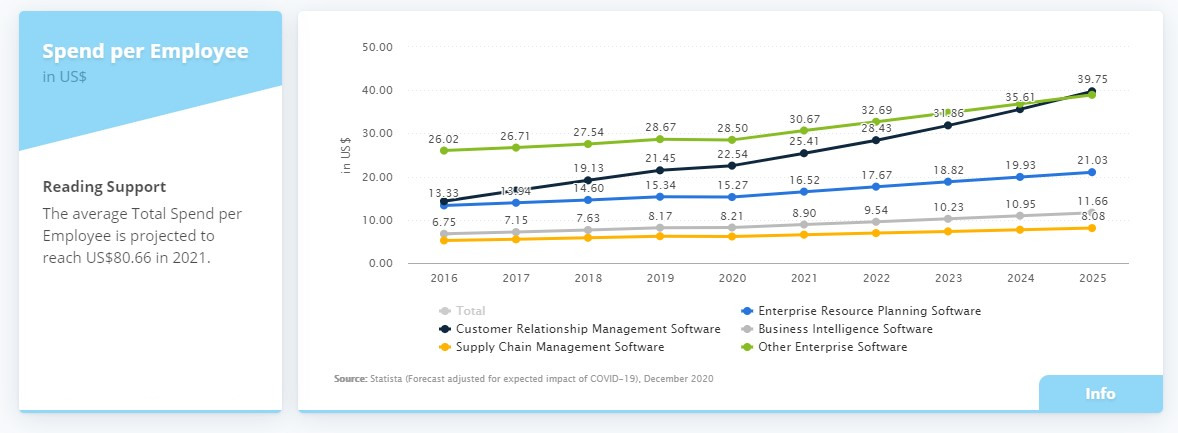Technical SEO Checklist - Factors Worth Analyzing
Regularly auditing your website for technical factors is important to ensure your digital asset is aligned with Google's best practices...

In the following article, we’re going to discuss the different types of enterprise applications, take a closer look at the development process, and mention the most common trends in the world of enterprise application development.
Enterprise software is used across a variety of industries. Below are a few examples of the popular types that can be found on the market.
ERP lets businesses integrate all their processes, including sales, marketing, finance, supply chain, and others, into one unified system. They use technologies like Machine Learning and AI to provide visibility and efficiency across every business aspect.
In a study of companies, the top three benefits businesses they gained from an ERP system are reduced process time, increased collaboration and a centralized data system. – netsuite.com

Enterprise software, including ERP, can support many processes in a company simultaneously. The key is proper integration with other systems in the company. / image source: mindk.com
CRM solutions are frequently used in sales and marketing. It gives them access to every interaction the business had with a client, including email, social media, phone, and even in-person meetings. It helps firms ensure that no sales opportunity is missed.
Business Intelligence solutions enable companies to turn data from various business areas, including sales, marketing, customer support, and others, into actionable insights. Based on these, they can make more informed business decisions.
HRMs are a critical tool in any enterprise. It allows companies to manage and automate repetitive tasks at all stages of recruitment and talent management. This type of enterprise software optimizes HR teams’ work, for instance, by helping them create recruitment workflows, evaluate candidates, manage team KPIs, and boost employee retention.
Supply chain management software allows large enterprises to manage multiple logistics, production, stock, or procurement processes. They enable companies to control each stage’s sound completion in the product life cycle and react upon any potential disturbances.
The enterprise application development process can roughly be divided into several key phases. If you choose to work with a software development partner, here’s what you can expect at each stage:
Market research is the first and single most important step in the enterprise application development process. When you develop an idea for a service or product, you must make sure that it responds to a genuine user need and/or fills a market niche. So, what can you do to ensure that the idea is feasible? Let’s take a look at two scenarios.
Custom enterprise applications are a specific type of software. Nowhere like here, we have to focus on solving the company’s specific problems and improving complex processes. Therefore, it is crucial to understand how the company works, its challenges, and its goals. It is also essential to create such software that will actually be used with pleasure by the employees and increase their work efficiency. Therefore, in addition to advanced algorithms, we pay great attention to user experience. COO, ASPER BROTHERS Contact Me
An enterprise company is looking for a solution that they can use internally. This means that the end-users of the solution are the company’s employees. Therefore, you need to conduct thorough research within the department that will be using the solution. There are two aspects you need to focus on – security and scalability. Let’s take a look at security first. In such a scenario, you need to ask yourself:
Secondly, let’s look at scalability. When choosing an enterprise application development services company, you need to consider your organization’s growth over time. The software partner you select working with needs to be experienced in developing large-scale solutions for enterprise clients. You cannot risk working with a software agency that can’t respond to your growing needs.
When creating enterprise software, you must also remember to include integrations with other enterprise tools in your SRS (software requirements specification) document.
In this example, let’s assume that a company wants to create a solution for sale. On top of the requirements specified in the previous scenario, i.e. user research, risk evaluation, and technical requirements, you must also conduct thorough market, competition, and legislative analysis.
Here are some questions to answer:
By the end of the requirements & market analysis stage, the goal is to have a project plan, which features an SRS document that states the technology that was chosen for the project, along with an estimated project timeline and budget.
That said, let’s review the further stages in the enterprise application development process.

Every year, companies spend more and more on enterprise software. In 2021, it will average $80 per employee. / source: statista.com
Based on the SRS document, designers create the initial design concepts. When accepted by the client, the designs are converted into high fidelity prototypes. The designers also create design requirements documentation for developers.
Coding is the longest step in the enterprise app development journey. Based on the requirements and design documentation, programmers work on coding the separate modules, which are developed and tested continuously, as explained below.
Once delivered, the software goes through multiple testing phases. In a software house, QA specialists and/or developers conduct evaluations such as unit tests, code quality, and security checkups. If errors or bugs are found in the code, the dev team corrects them.
If the software is error & bug-free, it can be deployed to the production environment and available to users.
Finally, once the software is up-and-running, it is continuously maintained and updated over time. This way, it can remain relevant to both the enterprise’s new requirements and the changing market and user needs.
Let’s now take a look at some of the trends which dominate the enterprise app development world.
It’s necessary to provide sufficient levels of security to minimize the risk of data leakages through:
This is especially important, knowing that the number of data breaches is on the rise. For example, in the US, a hacker attack takes place every 39 seconds. To improve data security, enterprise web applications should have the following features in place: user authentication, data encryption, backup control, and compliance tracking.

Source: www.varonis.com/
More and more companies opt for chatbots to handle customer queries and drive more customer engagement. According to Finances Online, 24% of enterprises, 15% of mid-sized companies, and 16% of small businesses now use chatbots. They also mention that by the end of 2020, roughly 80% of companies will have chatbot automation of some sort.
Cloud computing is also gaining momentum. In fact, according to a study conducted by Deloitte, 94% of businesses declare to be using SaaS in 2020, with 70% of CIO’s admitting to favouring SaaS over other solutions due to their scalability and agility.
By 2022, global cloud app spending will reach $226.9 billion, and cloud platform services will reach $70 billion.
source: netsuite.com
Progressive Web Applications are another important enterprise app development trend. Created by Google, PWA is a web app solution that offers mobile users an experience closely resembling native apps. There are several reasons why companies decide to create PWAs – among others, impressive user engagement, page speed, security, and a spike in conversion rates.
In fact, according to data shared by Google, companies who have turned to PWAs note a rise in the conversion of up to 52% and an average page load time of 2.75 seconds (8x faster than on a website).
The enterprise application development market is undoubtedly on the rise. It is predicted that in 2021, the sector will have grown by an impressive 7.2% within just a year. While this creates a great opportunity for software creators, it also comes with its set of risks.
Firstly, before you act upon your enterprise application development idea, you need to conduct a thorough market & requirements analysis. You must take into account factors like your competition, user needs, legislation, and project risks. You should also pay close attention to your software’s security and scalability, as these are of paramount importance to enterprises. That said, we recommend working with a software development partner who has experience developing enterprise tools, as they will be able to guide you through the path towards a successful market launch.

Regularly auditing your website for technical factors is important to ensure your digital asset is aligned with Google's best practices...
Are you dealing with a huge project right now and you need a helping hand? Whether your company is growing and If you answered yes for any question you definitely must read this post...
A successful software development team works like a well-oiled machine, with each team member making important contributions to the final...